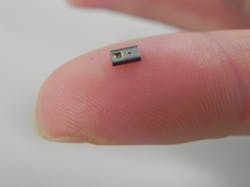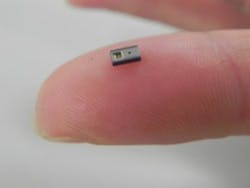Kyocera optical blood-flow sensor targets wearable devices, smartphones
Kyoto, Japan. Kyocera Corp. announced that it has developed one of the smallest known optical blood-flow sensors, which measures the volume of blood flow in subcutaneous tissue. With the sensor, Kyocera is researching a variety of mobile health (mHealth) applications such as monitoring stress levels or preventing dehydration, heatstroke, and altitude sickness by studying trends or changes in blood-flow volume. The company is developing algorithms for detection of these conditions in order to provide alerts.
Leveraging Kyocera’s expertise in miniaturization, the sensor—only 1 mm high, 1.6 mm long and 3.2 mm wide—is designed for use in small devices such as mobile phones and wearable devices. The company will offer sensor module samples starting April 2017 and aims to commercialize the technology as a device by March 2018.
The wearable device market has expanded substantially in recent years, focused primarily on health and fitness. New mHealth applications are being developed for a wide range of healthcare applications including chronic diseases, eldercare, and wellness. Global shipments of healthcare wearables are expected to rise from 2.5 million units in 2016 to 97.6 million units in 2021.1
Kyocera, which provides a wide range of components for smartphones and wearables, has been developing slimmer, smaller products to support higher functionality in more compact devices. The company developed this sensor as an integrated module, incorporating the laser diode and photodiode into a single ceramic package, based on its established expertise in miniaturization technologies.
Devices equipped with this new sensor will be able to measure blood-flow volume in subcutaneous tissue by placing the device in contact with an ear, finger, or forehead.2 When light is reflected on blood within a blood vessel, the frequency of light varies—called a frequency or Doppler shift—according to the blood-flow velocity. The new sensor utilizes the relative shift in frequency (which increases as blood flow accelerates) and the strength of the reflected light (which grows stronger when reflected off a greater volume of red blood cells) to measure blood-flow volume.
Featuring a high signal-to-noise ratio, small size, and low power consumption (output is 0.5 mW), the sensor can be easily integrated into a smartphone or wearable device for mHealth applications.
Notes:
- Based on information issued by Tractica LLC in April 2016.
2. The sensor targets capillaries for measurement and cannot be utilized on all parts of the body; measurement site may depend on monitoring applications.
About the Author

Rick Nelson
Contributing Editor
Rick is currently Contributing Technical Editor. He was Executive Editor for EE in 2011-2018. Previously he served on several publications, including EDN and Vision Systems Design, and has received awards for signed editorials from the American Society of Business Publication Editors. He began as a design engineer at General Electric and Litton Industries and earned a BSEE degree from Penn State.

